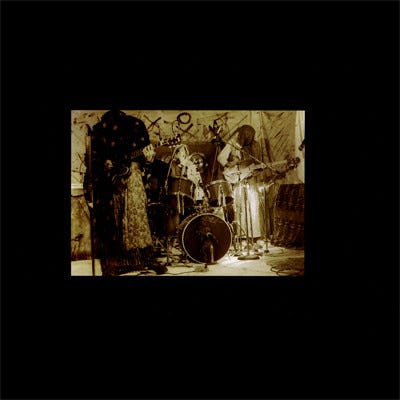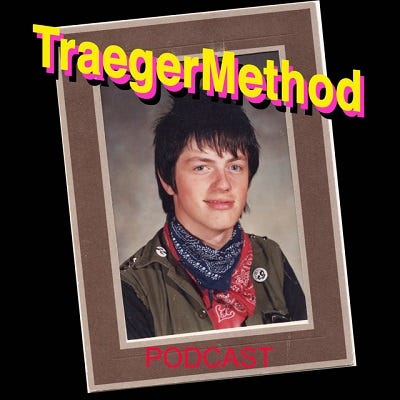STUFFS & THINGS & THINGS & STUFFS (STTS-016)
Grateful Dead, David Bowie, Faust, The Beatles, The Chiffons, Velvet Underground, Dick Dale, Wolf Eyes, Sun Ra, Sun City Girls, podcast host Jason Traeger as modern-day Alan Watts?
THIS WEEK IN CLASSIC ROCK DEPT.: Did you know it’s possible to love the Grateful Dead while also hating many things about them at the same time? Although I will love the Dead forever it’s been like 4 or 5 years since I’ve actively listened to them. I sometimes think I might never intentionally listen to them again (though I will keep reading about them, gimme any Dead book and I’ll read it in 2-3 days tops, the latest being Fare Thee Well by Joel Selvin), but just now came across this “5 Hour ‘Jams Only’ Compilation” and found myself hitting play. Not ten minutes later (felt more like twenty, and not just because of the ad break) I’m midway through the second of two “Dark Star” excerpts in a row and I’ve got all kinds of thoughts. First of all, I’m still fascinated every single time I pick up on Bob Weir’s exact guitar part. It isn’t easy to follow Bob, and I find myself almost never noticing what he’s playing unless I force myself to. He’s quite a soft-spoken instrumentalist, but when you squint your ears real hard and pick him out, it’s kind of unbelievable how much lead playing he does, single-note playing at least (lots of time spent in the upper register, traditionally the domain of lead guitar), always very melodic while somehow never fully neglecting his rhythm guitar role. Maybe that was how the Dead truly broke their songs wide open, by Weir learning to release/transcend the rhythm guitar role. The other big thought I’m getting is that yes, the jams are why I love the Grateful Dead and yes, the jams are when they’re at their most psychedelic, but no, the jams alone do not cut it. A “5 Hour Jams Only Compilation” sounds great in theory, but not so much in practice. You need the singer/songwriter side, the relatively straight presentation, the counterweight that anchors down all the surrealist space (and yes, a fair amount of empty-carb noodling) of these endless jams, just like Bunuel and Lynch shoot plenty of straightforward dramatic scenes in order to establish a conventional reality which makes their surrealist nightmares all the more jarring. I found myself, not even 45 minutes into this 5-hour edit, still listening to and loving every note, but frankly low-key desperate to hear Jerry or Bob (okay, mainly Jerry) soar back in with a soulful sung melodic setting for one typically whimsically deep Robert Hunter lyric or another. Knowing those sweet vocals would never come was kinda not chill, tbh.
THIS WEEK IN CLASSIC ROCK PART 2 DEPT.: As for David Bowie, just letting you know that I highly recommend taking his line “it’s a crash course for the ravers” from “Drive-In Saturday” on Aladdin Sane and singing “it’s a draft horse from Arabia” instead. Try it, it’s lots of fun (and for variety you can sing “pack horse from Arabia” or “fast horse from Arabia” too). By the way, what was Bowie talking about back in 1972 when he was singing a line like “it’s a crash course for the ravers”? Perhaps it’s an example of what Brett Morgen was trying to say as a guest on the WTF Podcast: “People tend to think [Bowie]’s a futurist. Like, there’s this interview where he’s talking about the internet that gets put on social media every three weeks. He wasn’t a futurist, he was, like a great artist, more sensitive to what was happening now. The rest of us just took a little longer to process it.” The now in “Drive-In Saturday” being 1972 when Aladdin Sane was released and Bowie’s already talking about 1990s rave culture.
THIS WEEK IN CLASSIC ROCK PART 3 DEPT.: Last time here at ye olde Stuffs, Things, Things, and Stuff, I mentioned my “FULL ALBUMS ON DECK” Shitify playlist that is 471 hours long and has 6,065 songs [sic]. Well, it’s a funny thing about playing such a large playlist on “shuffle all” mode — the software, or my computer, or something, clearly isn’t able to truly shuffle all, instead favoring a smaller subset of albums, only truly shuffling say 50 or 100 of those 471 hours, I assume because of RAM limitations. Granted, that could still be 50 or 100 or even more albums, which is actually a hell of a lot, but when you’re listening to that playlist all the damn time, you can’t help but notice tracks from the same albums coming up again and again. Like right now, this past week I’ve been in a shuffle-all stretch where once or twice a day a track comes up that sounds crazy, like retro 1970s but in a way that would also be cutting edge if it was brand new. Punky and noisy but also with groove and feel, like This Heat but a little more loose and funky. No vocals except weird wordless ‘mineralized being’ styles (grunts, really) (and thank you to Simon Reynolds in Rip It Up for the phrase “mineralized being,” which he used to describe Stephen Mallinder’s treated vocals for Cabaret Voltaire). Every time one of these tracks comes on, I dig my phone out of my pocket to see what the hell is playing, not having a clue, and every time it’s the same album: Punkt by Faust. This was the lost last album recorded by the original lineup in May of 1974, a few months after IV was released, and known as “the Munich album” because [take it away, press release]: “the band recorded it in Munich after returning from a doomed UK tour - it was supposed to be released on Richard Branson's Virgin label, following their impressive 1973 ‘The Faust Tapes’ full-length, but after ten days of recording Branson never paid the bill for the studio. The band were arrested until their family paid off the studio, and the master tapes were hidden in a secret location until they were dug up decades later.” The label Bureau B called it Punkt which is German for “Full Stop” and indeed Faust didn’t release another “official” album until their 1994 semi-reunion that yielded Rien. My question is: does Punkt feature the same material that came out here and there on various compilations like Munic & Elsewhere (1986, Recommended Records) or The Last LP (1988, ReR Megacorp) with track titles like “Party 8” and “Party 3” or whatever? Or is it different tracks from around the same time? I realize I could do a little forensic comparison listening, maybe someday…

THIS WEEK IN CLASSIC ROCK PART 4-6 ETC. DEPT.: Did the Beatles get that killer descending “now these days are gone” counter vocal in each verse of “Help” from the third verse of the Chiffons’ “Sweet Talking Guy” when their counter vocal goes “stay away from him/no no no you’ll never win”? I think they did. I’m sure they did. The exact moment in “What Goes On,” if you were wondering, when Lou R. takes his rhythm-guitar right hand from ‘playing the song’ into ‘flowing streaming shuffle-variation bebop-rhythm outro’ is 3:18, and then he doubles and triples down on it when the verse comes around again at 3:50 and 4:22 before that long bittersweet fade (which makes you miss the way they play it on live bootlegs, dead-stopping it to the requisite seven or eight people cheering). Speaking of outros, that flight o’ the bumblebee-ish piano on “Miserlou” tho. And, check this excellent rig rundown with Wolf Eyes in Reverb magazine. Wolf Eyes count as classic rock because they’ve been together 25 years and “classic rock” as a radio format was established in roughly 1986, and 25 years before that was 1961, well before most of the late 1960s and early 1970s music on the so-called “classic rock” playlists was recorded. Funny how this here BlastiStack newsletter has now called Wolf Eyes both “21st century composition” and “classic rock.” Apparently both can be true!
FAVORITE SUN RA ALBUM DEPT.: I’ve finally decided what my favorite Sun Ra album would be if I had to pick one (and thank goodness I don’t): Soundtrack to the Film Space is the Place (1973). Maybe it’s because I love the film so much, and these beloved wild spacey sounds immediately make me remember and reimagine the film’s beloved funky spacey visuals, but if you take the images out of the (immeasurable) equation completely, and just listen to the music, there really is something about the way this (apparently uncredited) San Francisco Bay Area recording studio sounded, a particular space and echo between the instruments that is quite unique within Ra’s entire discography. I also wonder if these are simply the same live performances we see filmed in the movie, so that the room with the uncanny sonic atmosphere is that very same room we see in the film, doubling as both a film studio and a music studio, and at the same time in the film doubling as a spaceship flying through outer space and then as a concert hall somewhere in Oakland, all via low-budget-movie montage magic. The CD credits just say, “All selections were recorded in Oakland, California, early in 1972, for inclusion in the film Space is the Place,” which does not disprove this theory. Either way, Sun Ra and His Intergalactic Solar Arkestra, numbering twelve in all, but here mostly breaking off into smaller duo/trio/quartet/etc cells for improvised miniatures, fill up this room with a sound and atmosphere that is alien, distant, and quietly haunting, even when the music is loud and noisy (and it often is, not to mention defiantly atonal). It is indeed one of Sun Ra’s noisiest and spaciest albums, but paradoxically and beautifully, it’s also one of his albums with the most hooks, featuring several classic June Tyson lead vocals and chants: the opener “It’s After the End of the World,” a sublime “Satellites Are Spinning,” and many more new and old such as “We Travel the Spaceways,” “Blackman,” “We’ll Wait For You,” and of course “Space is the Place.” (Just for context, my runner-up favorite Sun Ra albums are the We Travel the Spaceways/Bad & Beautiful twofer on Evidence and the Cosmic Tones for Mental Therapy/Art Forms of Dimensions Tomorrow twofer on same.)
SUN CITY GIRLS PUZZLE PIECE I FORGOT WAS MISSING DEPT.: “Glass Globe,” recorded live in performance on 10/30/1982 in Phoenix, Arizona at the historic Alwun House Art Gallery (a gallery venue founded in 1971 and still standing and booking events today in downtown Phoenix at 1204 East Roosevelt Street), featuring an early Sun City Girls quartet lineup of Charles Gocher on drums, Alan Bishop on bass, Rick Bishop on guitar, and Linda Cushma on synthesizer and vocals. In fact, 10/30/1982 was the first SCG show with Gocher on drums. Cushma had been the band’s drummer, but upon Gocher’s arrival moved over to synthesizer, here playing killer heavy melodies that take “Glass Globe” somewhere SCG didn’t quite go again after her departure from the band a few months later (although perhaps a case could be made for Eyvind Kang’s guest violin on “Ghost Ghat Tresspass/Sussmeier” taking them somewhere similar, albeit with differences just as strong as any similarities), even as the other three musicians are already doing quite regular SCG things: those super-thick Alan Bishop bass chord changes, those Arabic guitar solo stylings of Richard Bishop, that somehow-Bonzoid jazz shuffle mastery of Charles Gocher. This recording of “Glass Globe” has been released twice, initially in 1987 on the inaugural tape in the band’s Cloaven Cassettes series, God Is My Solar System, and then again in 2003 as part of a double LP release.
PAINTING WITH JOHN S1E1 DEPT.: My brief review of Painting with John S1E1 is that it’s pretty great and at the same time pretty boring, (intentionally) not as hilarious as his previous show Fishing with John was. I also hope that I too can retire to an undisclosed rainforest sea cliff Caribbean location and make art full time someday. Also, some/most/all of John’s soundtrack music really shreds. (Especially the clarinet/guitar/water drums (?) piece that starts around the 8-minute mark, I’d love an OST album, or is this what the Marvin Pontiac records I’ve never listened to sound like?) And, one last thing: I took his challenge at the very end of this debut episode and wrote a poem about the sunset he was looking at (it’s haiku, which might be cheating, but I need all the help I can get): “Golden orange fades grey/Black tree silhouette on sky/Sunset over sea.”
TRAEGERMETHOD PODCAST E79 DEPT.: Came for the Tony Rettman interview, stayed for the Alan Watts-worthy introduction by host Jason Traeger. Been thinking about what he says enough that I went ahead and typed a bunch of it up for further rumination. I realize this might seem weird, that I’m over here transcribing a podcast intro, and apologies to Mr. Traeger (you’re welcome to send corrections, cease & desist orders, whatever you’d like, larrydolman at gmail dot com), but I really just wanted to get it down on ‘paper’ for myself and who knows, maybe the reader will appreciate it too.
First of all, he defines that elusive concept of freedom in what I find to be a novel and effective way: “Freedom — personal freedom — is the space between action and reaction. Like, there’s a stimulus. Whether it’s a thought or something happening outside of you, the thing presents and then you react to it. The amount of space between those two things is what personal freedom is. That, and the space between thoughts completely. The sections of life where there’s no story being told to yourself. That’s freedom, and it’s freedom when you have that choice between, or that space. Any space, I guess is what I’m saying, is freedom. But that space between action and reaction, that’s where freedom is.”
Then, he takes this idea of the potential and variable space between action and reaction and applies it to the practice of meditation: “Like with meditation, you’re not trying to eliminate thoughts, you’re just trying to notice them for what they are, and then notice also that there’s space between them. And I guess the one part of meditation that I see as kind of the ‘workout’ aspect is to notice those spaces in between thoughts and maybe extend them a little, but even that, you don’t want to do too much work trying to do that. Just notice them. There’s thoughts, and there’s spaces in between thoughts. The thoughts are secondary to the space in between thoughts — or, maybe not secondary. Maybe that’s not the right word. They’re additional. They’re in addition to. Like you’re alive, breathing, in awareness when you’re in dreamless sleep, then you wake up, and on top of that state that was already there, that baseline non-experience, comes the experience. The world turns on, turns off. But, that state of no experience, no story? That’s always there, and when you die it’s there, if you think about that. Like, what is the difference between dreamless sleep and death? For you, in your experience?”
Okay, so the topic of death has been broached. My death, his death, your death, our death, but Traeger goes deep here too, in a way that is reassuring: “When you view yourself, you define yourself as an object in space and time who came into being and is going to go out of being and you see yourself as one of many. Yeah, you’re always going to be trying to get things just right. Avoid the bad and court the good. Control things is naturally going to be what you need to do, to keep things decent, or good, or livable, or pleasurable, or whatever. You’re going to always be doing that, on some level, and you’re always going to be falling short of it, no matter what you do, no matter what you achieve. There always can be more, it can always be better, it can always be safer, it can always be done better . . . and it’s only for me, in my life, the only time I’ve ever sort of felt relief from that, is by just looking at myself differently, defining myself completely differently, and saying, ‘Oh, I am not an object in space and time. I am this reality. Deathless, ever-present, here now, exactly as it is.’ It’s the only thing I actually ever experience. And if there’s no story going on from me, then it’s not even me experiencing it, it’s just, boom, this. And, that’s the only place I’ve found that I can rest, where I go, ‘Oh, I don’t have to fear death right now, because I’m in a deathless ever-present state.’ Death is just an idea that enters the mind. It’s never a thing that I actually experience. It’s always in the future ahead of me, suspended ahead, which means it only exists in the imagination where the future always resides.” Goddamn, he just keeps going — I had to transcribe this whole part too, because of the Nisargadatta Maharaj quote: “Go with the flow, realize you have no control — those things are much easier to accept when you don’t identify as an object in space and time. One Nisargadatta Maharaj quote that I love, and one of his most famous ones, is: ‘The mind creates the abyss; the heart crosses it.’ What does he mean by that? I think of the abyss as the thing where you say, ‘God is over there. He’s a being over there. It’s a force over there, that I need to somehow get to.’ That’s the abyss. ‘I’m an object and there’s other things over there, there’s other stuff over there, there’s a better life over there.’ That’s the abyss. And that’s created — you know, that’s the mind, that’s just generated by thoughts. The mind is the story engine. The heart, representing love, this love which collapses the separation — the heart crosses it. The mind creates the abyss, the heart crosses it. And I’ve mentioned it before, that painting of Adam and God on the Sistine Chapel ceiling? That little gap between the fingers? That’s what creates the Catholic Church. That’s why they have that as the central painting of the place, of the Vatican, in people’s imagination. That painting, that image, that central thing of that central painting [on the] Sistine Chapel ceiling. And it’s like that gap is why you need the Catholic Church, because God’s over there, you’re separate from Him, and we’re the bridge. That’s our purpose, is to be the bridge. If God and Adam are touching, and they’re one, then you don’t need the church. You don’t need the guy with the funny hat to be your ambassador to God if it’s all one. So naturally, that’s the painting you got on the ceiling there. Part of the logo, part of the ethos. I’m not about that. I say ‘No, it’s all just one thing.’ Which is actually so complete that it could also be called nothing, but both are incorrect because it’s neither one. It’s not a thing.” Damn, all that (and more) in a 15-minute podcast intro, not bad!








